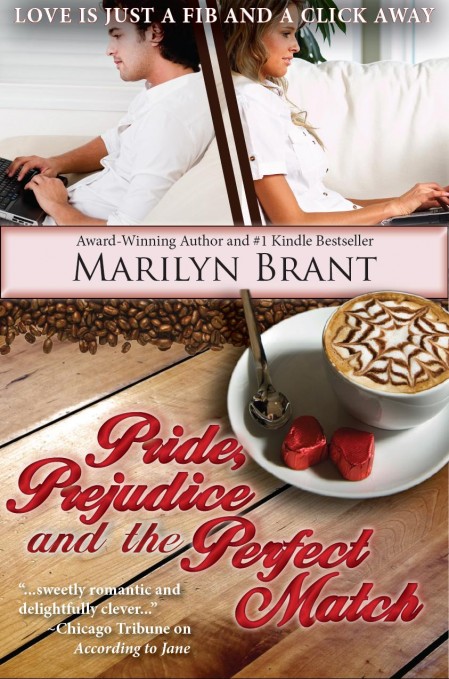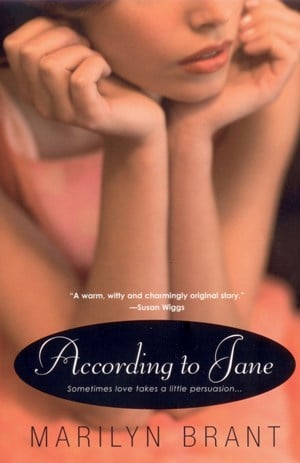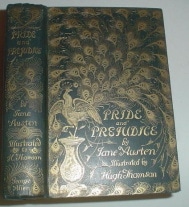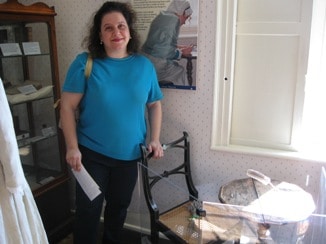
It’s always both fun and a learning experience when author Marilyn Brant is our guest blogger: If you stroll through the childhoods and young adulthoods of future writers, you’ll always find a unique set of novels and/or films that left a particularly strong mark. Stories that influenced the very worldview of that writer-to-be by stamping it with an indelible impression of skillfully paced plots, believable motivations, insightful characterizations, clever subtexts, and compelling themes.
We all have our own private shelves—literally or figuratively—that feature these memorable examples of storytelling. Forevermore, we hold up their masterful narration as our personal standard of excellence. The one we hope to rise closer to… someday. If we practice really hard. And if the writing gods smile upon us, even slightly.


This month, the worlds of both classic lit and genre fiction unite in honoring Jane Austen, an author who is one of my greatest literary influences. Her second published novel—that work of staggering genius we know as Pride and Prejudice—turns 200 years old on January 28th. For me, it’s a double celebration. I was, admittedly, under the influence of Austen and her comedy of manners when I wrote my debut novel, According to Jane (Kensington Books, 2009). It’s a romantic women’s fiction story about a woman who has the ghost of Jane Austen in her head giving her dating advice for two decades. Some called the book “highly imaginative.” Others called it “weirdly psychotic.” (I’m kinda biased, so I’ll let you decide.)
Now, four years later, I’m celebrating the release of my seventh novel, Pride, Prejudice and the Perfect Match, which is the first book since my debut to give such an obvious nod to my literary idol. This story is a contemporary romance about an ER doctor and a single mom who cross paths on an Internet dating site. Both have motives aside from meeting their “love match,” and both think they’ll be able to get what they want—fast, easy, and without endangering their hearts. We all know, though, that the course of true love (or carefully plotted fiction) will never run that smoothly…
Miss Austen did not have the benefit of Blake’s beat sheet at her writing desk, like I did when I drafted my novels, but that doesn’t mean her work didn’t exemplify the same brilliant storytelling techniques Blake so clearly illuminated for us. In honor of them both, here is my best attempt at writing out a beat sheet for Pride and Prejudice:
1. Opening Image: Mrs. Bennet, a Regency-era mother to five single daughters (Jane, Elizabeth, Mary, Kitty, and Lydia, in order of age), is yammering on and on to her husband about how a new eligible and wealthy bachelor just moved into the neighborhood.
2. Theme Stated: C’mon you British lit buffs—or fans of Colin Firth—say this one with me: “It is a truth universally acknowledged that a single man in possession of a good fortune must be in want of a wife.” (Imparted to readers with a heavy dose of irony.)
3. Set-Up: We get to know the Bennet clan, particularly sweet/beautiful Jane and witty/opinionated Elizabeth, as they interact as a family and go to the Meryton Ball—the first of the major balls in the novel. (Really, don’t read this book if you can’t abide dancing.) We then encounter the object of Mrs. Bennet’s interest, Mr. Charles Bingley, who is in attendance with his snobbish sister Caroline, his other snobbish sister and her husband and, most interestingly of all, his best friend. Enter the even wealthier and handsomer—albeit, significantly prouder and more arrogant—Mr. Darcy. Despite how literary convention might expect us to think that Bingley’s romance with Jane should be the primary one in the novel, it is not. We get to contrast “pride” and “prejudice” in action as Bingley’s best friend Darcy and Jane’s dear sister Elizabeth meet.
4. Catalyst: Darcy scoffs at the idea of dancing with Elizabeth, no matter how fervently his good-natured buddy implores him to do so. He growls that she’s “tolerable” but not handsome enough to tempt him. Elizabeth overhears this conversation, and you can imagine how well that goes over with her. Her true character, though intelligent and, at heart, quite loving, is one of a woman with a LONG and exacting memory. And Darcy, who spoke in haste and out of irritation at being in unfamiliar circumstances alongside people with whom he didn’t share many interests, would live to regret his uncharitable words.
5. Debate: Others may disagree with me on this point (so feel free to counter), but I’d argue that the A Story is all about Mrs. Bennet wanting to marry off her daughters and the debate here is a series of discussions from the perspectives of multiple characters regarding the nature of courtship and marriage. To Mrs. Bennet, it’s all about money and luxurious living. To Charlotte (Elizabeth’s best friend), it’s about finding a respectable man and comfortable home. To Jane, it’s love and kindness. To young silly sisters Kitty and Lydia, it’s handsome officers. Elizabeth requires something more in a spouse—intellectual respect—while Bingley and Darcy debate the qualities they admire: pleasant manners and attractiveness (Bingley) versus being clever and accomplished (Darcy). And for the Bennets’ relative, Mr. Collins, it’s finding a woman his patron, Lady Catherine (Darcy’s rich and obnoxious aunt, no less!), would approve of, given his standing in the church. Everyone argues their positions.
6. Break into Two: Elizabeth’s romance with Darcy really begins (and not well). She makes a choice to visit Jane, who has fallen ill during a lunch date with Bingley’s snobbish sisters, and she must brave the irritations of Darcy and Caroline in order to give comfort to her dearest sister.
7. B Story: In spite of himself, this is where Darcy really starts to like Elizabeth—particularly her fine eyes and her liveliness of mind. It’s also where her dislike of him is even more firmly cemented.
8. Fun and Games: Oh, there are evening balls and many witty remarks, plus the appearance of new people on the scene and much dating/courtship action. The promise of the premise is in full swing here with marriage proposals, sudden departures, rampant social gossip, and rakish men. Mr. Collins proposes to Elizabeth. She refuses, so he proposes to her friend Charlotte, who impulsively accepts. Mr. Darcy and the Bingley sisters persuade Mr. Bingley to leave town, and Jane, in hopes of crossing paths with him again, leaves as well to stay with relatives in London. Elizabeth, who has already met the cunning but charming officer Mr. Wickham (also the son of Darcy’s late father’s steward—follow that?), begins to learn of even more horrible deeds that Wickham has attributed to Darcy. She readily believes them.
9. Midpoint: Elizabeth takes a trip to visit her friend Charlotte, now married to the foolish Mr. Collins, and encounters the formidable and frequently rude Lady Catherine. Since the Lady is Darcy aunt, it’s not so implausible that Darcy suddenly shows up there, too. It is, however, a shock to all of us when Darcy unexpectedly proposes to Elizabeth (badly). Less of a shock is that she immediately refuses him, citing his interference in her sister’s romance with Bingley and his nastiness to “poor Mr. Wickham.” Let’s just say, none of this is how Darcy imagined things would play out. He storms off and writes a long letter to Elizabeth, explaining that Wickham is a really bad guy. Both Elizabeth and Darcy have been prideful and prejudiced in a number of ways, and the state of both of their love lives seems pretty pathetic right about now.
10. Bad Guys Close In: This is where the plot thickens. The officers of the regiment, including Mr. Wickham, leave the area for another town. Youngest sister Lydia gets an invitation to go there with a friend and her father lets her go, against Elizabeth’s advice. Elizabeth, meanwhile, gets to take a new trip—this one with her sensible aunt and uncle from London. They head north to the region of Derbyshire, where her aunt grew up and, coincidentally, where Darcy’s famous estate of Pemberley is located.
11. All Is Lost: GASP! Darcy is THERE in Derbyshire, too! After some months apart, during which he has regretted his ungentlemanly behavior and she has regretted believing Wickham’s lies, the two see each other for the first time, mutually humbled and with much clearer vision. They talk and are on the verge of something very courtship like when disaster strikes. Jane writes a letter saying that Lydia has run away with Wickham and the two cannot be found.
12. Dark Night of the Soul: Elizabeth must return home, knowing that Lydia’s actions will forever tarnish the reputation of her family and that Darcy wouldn’t want anything to do with her now. Because of his earlier warnings about Wickham, she confesses to him what has happened with her youngest sister and, basically, says goodbye to him. She knows any further relationship between them is hopeless. It’s heartbreaking. Just when both she and Darcy had finally escaped their pride/prejudice toward each other, they are torn apart.
13. Break into Three: At home, Elizabeth consoles her mother and her sisters while her father is in London attempting to locate Lydia and hoping to convince Wickham to marry her, rather than leave her a “ruined” woman. Elizabeth, fully understanding now that Darcy was telling her the truth about Wickham’s character, is more stunned than anyone when they all find out that Lydia and Wickham are engaged and about to get married. It is a terrible match, but it is the only thing that can be done to save the family’s reputation. Mrs. Bennet is ecstatic to finally have one daughter married, even under these circumstances.
14. Finale: Wickham and Lydia visit the Bennets as a married couple. Elizabeth is wiser now and distances herself from Wickham and his Darcy-bashing speeches. Lydia lets a secret slip—Darcy was with them in London—which makes Elizabeth crazy with curiosity. She begins to investigate. Meanwhile, Bingley suddenly returns, seeks out Jane and, eventually, proposes. Jane says yes. Lady Catherine surprises Elizabeth with a visit, demanding that she stop pursuing Darcy. Elizabeth is seriously confused. She hasn’t seen Darcy in a while and, though she respects him now, she’s quite sure she’s not secretly engaged to him. Nevertheless, she tells off his aunt with her best Regency-era insults, and is further stunned when Darcy himself shows up soon afterward. Elizabeth has learned that HE was the one who found Lydia and paid Wickham off to marry her. When Darcy proposes a second time, Elizabeth accepts with pleasure.
15: Final Image: We have the weddings of the “two most deserving” Bennet daughters. With three out of the five young ladies now married, Mrs. Bennet is beside herself with delight. And it’s a happily ever after ending for those characters who have earned it.

So, for all of my fellow P&P fans out there, how did I do? Would you change anything? And, for everyone, what are some of the books or films from your youth that most influenced your writing? Wishing you all a wonderful 2013!
Check out our other novel-writing blog posts.
Jessica Brody will consult on your novel and analyze your beat sheet according to the Save the Cat!® principles. Learn More>>
Marilyn Brant
19 Comments
Leave a Reply Cancel reply
You must be logged in to post a comment.









Lovely Beat Sheet Marilyn! The only thing I would add is to Charlotte- in addition to finding a respectable husband when she is well “on the shelf” she also gains for herself the respectability and social status of a married woman- a condition not to be sneezed at in Regency times! Best of luck on your latest book- hope to see you in Minneapolis in September!
Ah, Carey, thank you!! Those are excellent additions to Charlotte’s motivations. And I’ve got my fingers crossed for Minneapolis, too. It would be wonderful to see you in person again!
I think you did a great job, Marilyn! It makes me want to pick up a copy now and reread it! :) Have a wonderful weekend! =)
Thanks so much, Jakki!! I’m glad you didn’t think I missed any important turning points. Hope you have a fabulous weekend, too!
And a note in case some readers didn’t realize it, in the photo of me above, I’m standing right behind Jane Austen’s actual writing desk. It was taken at her house/museum in Chawton, England. I was hoping some of her brilliant writing vibes would rub off… :)
Marilyn, I’ve changed the photo caption to point out where you’re standing! Thanks!!
BJ, thank you! So nice of you to add that in!! And thanks again for inviting me to visit. It’s always a pleasure to be here ;).
Lovely Marilyn, I have always wanted someone to break down P&P for me. You did an excellent job.
Laurel Ann,
Thank you so much!!
That means a great deal to me, especially coming from someone who knows and loves Austen as you do :).
Really enjoyed this, Marilyn. I’ve not seen a Beat Sheet before (I know – shocking!) ;) and it was both a fun read and interesting. Love the picture – Chawton Cottage is such a joy to visit, isn’t it? I swear you can feel Jane’s presence all around.
I was just thinking about this the other day. It’s great to see it all laid out so well. Great job Marilyn!
Cassie,
I’m so glad you liked the beat sheet! Blake came up with an incredibly helpful tool for writers, in my opinion. I use it all the time. And, yes, to what you said about Chawton Cottage!! It felt as though Jane might just walk through the doorway at any moment and remark with a raised eyebrow that there were far too many people wandering about her room… :)
Grace, thank you so much! I’m very glad you felt I got the beats right for P&P, and I really appreciate you took the time to stop by. Wonderful seeing you here!!
Hi Marilyn. Great Beat Sheet. I confess I haven’t read the book since high school, and also failed to see the Colin Firth version (though love him, of course), but absolutely adored Joe Wright’s film adaptation which was an interesting fusion of Austen and Bronte, making Elizabeth quite comfortable out on the moors, which is something I can’t remember about the book — her “earthiness” — and is something I suspect evolved with the filmmakers. Personally I loved it and think it’s basically a perfect film. I could see it unspool before me as I read your beat sheet, so it appears they followed the story very closely, though of course they added a scene at the end (sacrilege?), though to me it was so sublimely written that I think JA herself might have quietly applauded. Speaking of channeling JA, I wonder what you think of Emma Thompson’s adaptation of S&S, and did you ever see her glorious Golden Globe speech where she read aloud a note she had written from JA’s pov about the evening? More sublimity. Anyway, I digress. Thanks for the great BS2, and congratulations on writing ten novels! Or it is more now? I’m amazed. Best,
Tom
Tom,
First of all, I adore Emma Thompson, and I loved what she did with “Sense and Sensibility.” And, yes, her GG speech, was fantastic! One of the most creative ever… Did you see her in “Stranger Than Fiction,” by the way? Even though it had nothing to do with Austen, I thought it was so delightful.
As for the Joe Wright version of P&P, there was so much I enjoyed about the production (not the least of which was Matthew Macfadyen’s intense portrayal of Darcy :-). I know what you mean about the “earthiness” of Elizabeth. I could really believe that line about her dress being “six inches deep in mud” after her walk to Netherfield, LOL. There was a lot of youthful energy in that adaptation, and I thought the main characters seemed to be the ages they were intended to be. My only wish was that the film could have been just a little longer because, due to necessity of only having 2 hours, they had to cut a lot of good stuff.
Anyway, thanks for your wonderful comments! It was great fun to chat with you about this, and I’m very glad you enjoyed the beat sheet.
Hi Marilyn. Indeed I saw Stranger Than Fiction. I don’t think I’ve missed an Emma Thompson movie. She’s a cinematic treasure. And now she’s writing a new version of Peter Rabbit! What that woman can’t do… I look forward to more of your beat sheets and maybe a novel or two down the road. Good luck with everything. Are you coming to the STC event in Burbank on 01.26.13? If so, I’ll look for you. Take care.
Tom,
One of these days I’d love to be able to come to an STC event in person (especially in January, when it’s so balmy in Burbank compared to the freezing Midwest!) but, unfortunately, it won’t be this weekend. I know you’ll have a wonderful time, though, and truly appreciate the good wishes. All the best to you, too!
Thank you very much for the excellent analysis. It is very interesting that the Beat Sheet can be applied to a novel of over 200 pages as well as a screenplay of 110 to 120 pages.
Also, another way to state the theme is to call it in the words of Anna Marie Quindlen, “the search for self.”
Joe,
I’m so glad you liked my analysis of the book — thank you! Jane Austen told the story so well, she made it easy for me to break it down :) .
And you mentioned something I absolutely love about Blake’s beat sheet — how applicable it is to both novels and screenplays. I have yet to try the latter, but I know if I ever did that I would really appreciate having the BS2 as a structural tool.
I just read Save the Cat! Writes a Novel (which obviously was written later than this post, I’ll call it STCWN), and was intrigued enough to create my own Beat Sheet for Pride and Prejudice. Then I came across this one, which I mostly agreed with. But I disagreed on some points:
STCWN says the Stated Theme was mary Bennet’s comments about pride and vanity as common failings, which comes at 5% in P&P. I agree with this, and think she adds to it at 8% when she adds that impulses of feeling should be guided by reason. These themes are confirmed after the Midpoint (Darcy’s proposal and letter), when 54% through P&P Elizabeth has her epiphany, recognizing her basic flaws of pride, vanity, and not being reasonable.
Catalyst and Debate: I think this is when Jane is ill and Elizabeth goes to Netherfield. There she and Darcy interact extensively, including discussions of vanity, pride, natural defects and Elizabeth misunderstanding people. We see character arcs for both Elizabeth and Darcy in the novel, and here we’re setting up both of them, as Elizabeth’s prejudices increase and Darcy fights his attraction to her.
Break into 2: I think this happens when Mr. Collins and Wickham arrive; they are the characters who push Elizabeth toward change–Mr. Collins by getting her to Rosings, and Wickham by increasing her prejudices and eventually showing her her failures in judgment.
The rest I agree with up to the Finale, which nicely fits the five points in STCWN:
Gather the team: Bingley and Darcy come back to Netherfield
Execute the Plan: Mrs. Bennet’s plan, and Darcy’s plan, to get Bingley to propose to Jane, both succeed
High Tower Surprise: Lady Catherine arrives to forbid Elizabeth’s engagement
Dig Deep Down: We see Elizabeth’s changed character as she resists Lady C’s slurs and pronouncements
Execute New Plan: Eliz’s new plan, thanking Darcy, succeeds in getting him to propose again, moving them toward their HEA in the final image.
This was a fascinating exercise, very helpful. So many things in the beat sheet happened right where they were predicted. And I’m impressed that it works so well on a brilliant novel written over 200 years ago! Thanks!
Brenda, WOW!! First of all, I absolutely love that you came upon this post (it’s hard to believe it’s been a decade since I wrote it…) and took the time to respond so thoughtfully. Thank you! I’m impressed by your analysis of the novel, and I’d agree with several of your suggestions. In looking at P&P, I think there are multiple themes at play (Austen was such a genius, wasn’t she?), but you’re right that pride vs. vanity is a major one and definitely worth adding. I also loved that you broke down the Finale and showed the 5 Points — I think you nailed it! — and I’m thrilled you’ve found Blake’s beat sheet to be as helpful as I always have. It’s such a wonderful tool for writers!